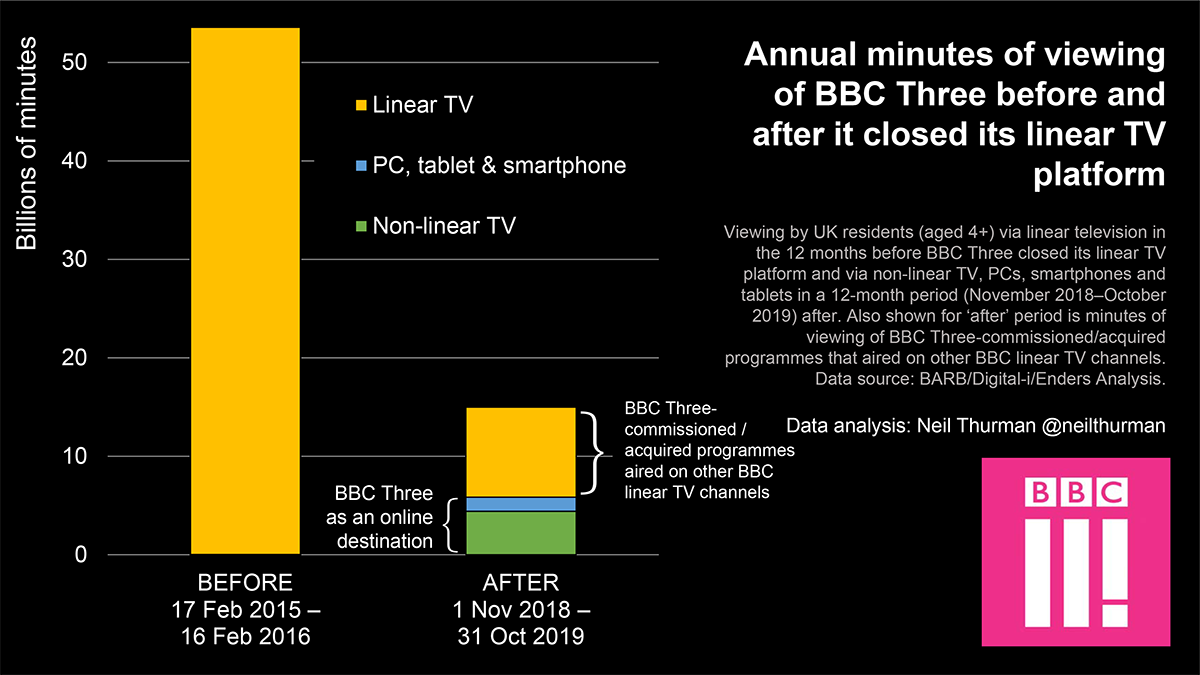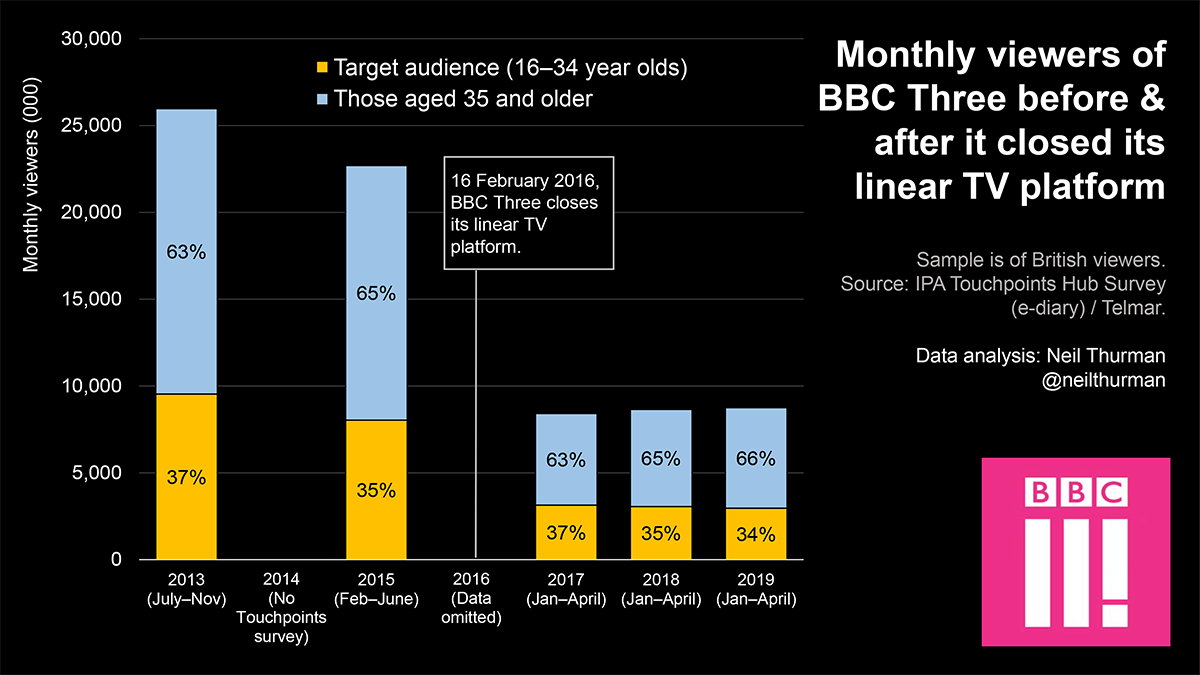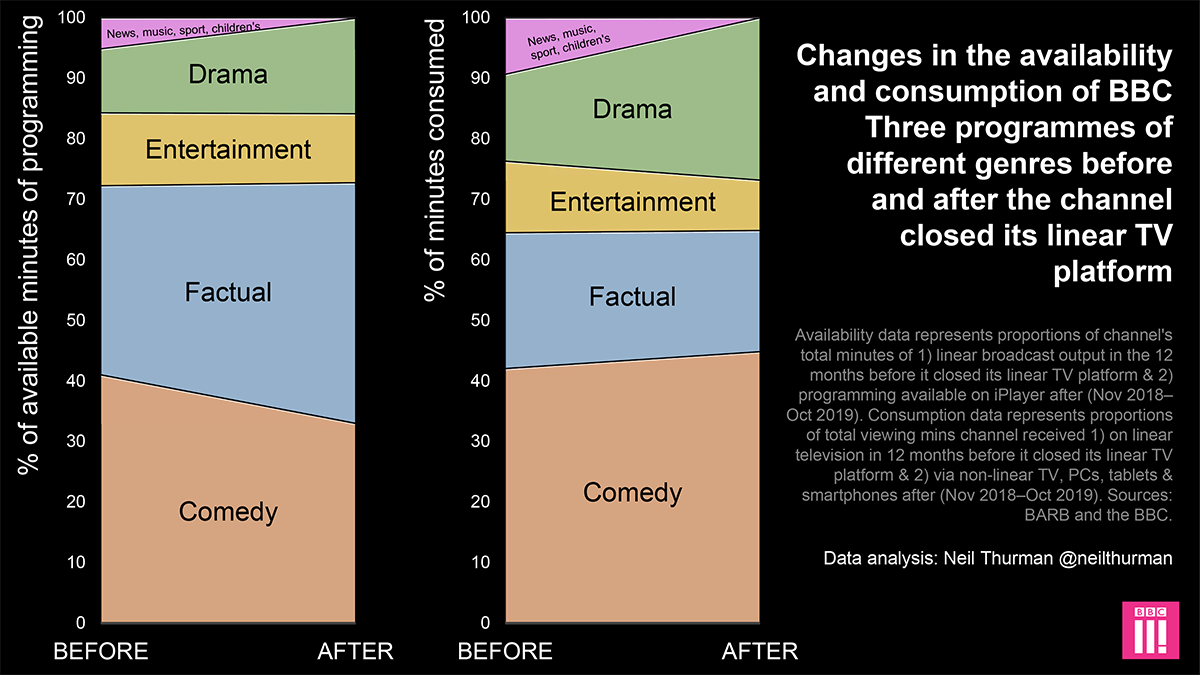Blog

by Neil Thurman
Time spent viewing BBC Three fell 89 per cent after the TV channel closed its broadcast platform
BBC Three was the first major TV channel to close its broadcast platform and reinvent itself online. Four years on the BBC is considering bringing it back to linear television. My new study is the first to analyse changes in how BBC Three is consumed and the shows it offers.
Today Enders Analysis publish an edited version of my study as a report to their subscribers. The full version, is published in Convergence. The main findings are summarised in this post.
Viewing minutes
First, BBC Three as a destination is viewed for 89% less time per year since it reinvented itself online than it was on linear television before. Even including the viewing of BBC Three shows aired on other BBC TV channels, the decline is still 72%.
Most—79%—of the online viewing is still via television sets—e.g. watching BBC Three on the BBC's video-on-demand service, iPlayer, on a Smart TV. So, the television set remains the preferred device for consuming televisual content, even at a channel that has reinvented itself online.
Gross Half-hour Claims (GHCs) is another metric showing how the intensity with which BBC Three was viewed changed after it stopped broadcasting. BBC Three’s GHCs fell 88%—with little difference between its target audience of 16–34 year olds and those aged 35 and over. This fall contrasts with BBC Three’s broadcast competitors whose collective GHCs rose 5.6%, and raises doubts about whether, in the context of BBC Three, young audiences were, as the BBC’s former Director General, Tony Hall, said, "most ready to move to an online world".
Time spent with BBC Three fell about as sharply as it did at The Independent and the NME, suggesting that the negative effects on time spent caused by closing their offline platforms may be similar in degree for both TV channels and print publications.

Audience reach
How did BBC Three's audience size—effectively its reach—change post broadcast? Comparing the year before it stopped broadcasting against the year after shows its 16–34 year-old target audience shrank 69% on a weekly basis and 60% on a monthly basis. BBC Three's post-broadcast losses in weekly (−70%) and monthly (−63%) adult British viewers of all ages were similar. I estimate the falls in audience size were up to five times higher than they would have been if BBC Three had continued broadcasting.
BBC Three’s falls in audience size contrast with its broadcast competitors. Their audiences did decline, but to a lesser degree. The closure of BBC Three’s broadcast platform caused at least three-quarters of the drop in its audience size.
Why was BBC Three’s monthly audience sharply reduced when it closed its offline platform when The Independent managed to maintain its monthly readership after it went online-only in the same year? One reason is likely to be that a much smaller proportion of BBC Three's audience consumed it online at the time it closed its offline platform. Another reason could be that BBC Three's net audience was in decline when it ended broadcasting whereas The Independent's net reader numbers were on an upward trajectory went it went online-only.

What is watched
Although BBC Three decided one editorial pillar of its online reinvention should be ‘Make Me Laugh’, the proportion of its output devoted to comedy actually fell post-switch, likely because it dropped US animation imports like Family Guy and American Dad.
Although comedy makes up a lower proportion of the minutes of programming available on BBC Three since it closed its broadcast platform, the genre accounts for a higher proportion of viewing minutes since the switch.
BBC Three has—as planned—increased the proportion of drama and factual in its output since it reinvented itself online. However, factual now accounts for a lower proportion of viewing minutes. Drama, though, now accounts for a higher proportion of post-broadcast viewing minutes.
Did, then, BBC Three's online reinvention influence the types of programme watched? Possibly, but only multivariate analysis accounting for variables such as audience demographics and programme availability will tell us for sure.

BBC Three is no longer the only TV channel to have reinvented itself online. In January 2020, the Danish Broadcasting Corporation's DR Ultra and DR 3 stopped broadcasting. Will their experiences mirror BBC Three’s? I expect they will.
This study develops what Richard Fletcher and I have called ‘Media Platform Cessation Theory’ in two ways. Firstly, by showing how change in the size of a media outlet’s audience after closing its offline platform may be affected by the proportion of its audience that consumes it exclusively offline before. Secondly, by showing how, irrespective of media platform, when media brands close their offline platforms they suffer sudden and substantial falls in the time audiences spend with them.
Thanks to Julian Aquilina who was a fantastic collaborator on the Enders Analysis version of my study. BARB and IPA Touchpoints provided data and Telmar and Digital-i data services. A special thanks to Matt Ross and Tony Forester at Digital-i; the IPA’s Daniel Flynn; Telmar’s Kevin Johnson; and BARB’s Simon Bolus, Sarah Mowbray and Doug Whelpdale. At LMU Munich’s Department of Media and Communication Velina Chekelova, Iuliia Khobotova, Antonia Klatt, Cosima Kopfinger, Iuliia Kozlovskaia, Maire Palias, Kseniia Tikhomirova, Lisa Tratner, Sarah Will, Chaoying Yuan and Tianrun Zhao helped greatly with data coding.
The full study is published in the international peer-reviewed journal Convergence.
Watch a seven minute presentation on the study (originally presented at the 2020 asi Virtual Conference):